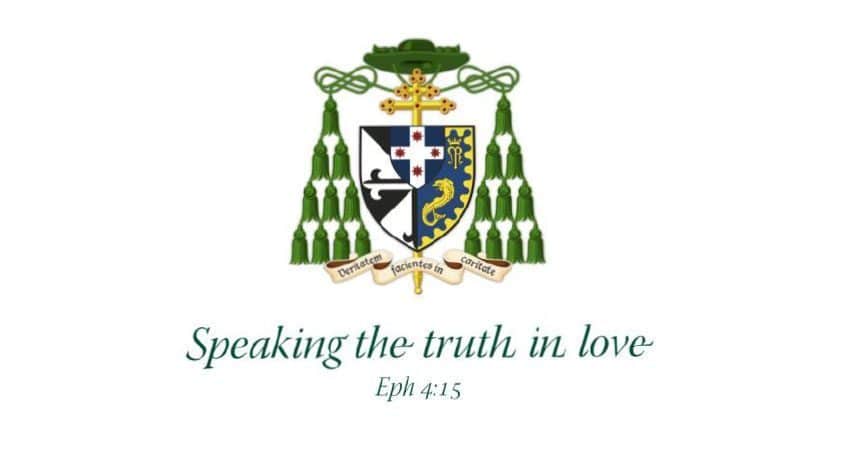Homily for Mass of the Sixth Sunday in Ordinary Time, Year B

St Mary’s Cathedral, Sydney, 11 February 2024
Rod Serling’s popular sci-fi series, The Twilight Zone, ran for five seasons between 1959 and 1964. : Ranked amongst the most successful television series of all time, it had a reputation for suspenseful, mind-bending narratives that ended with a clever, unforeseen twist. The Twilight Zone has since been remade three times as a TV series and twice as a movie, as well as live theatre and radio. There have been games, comic books, novels, even a Twilight Zone theme park attraction at Disney in Orlando, Paris and Tokyo.[1] Before each of the original episodes, Serling delivered a cryptic monologue setting the stage for the characters and events about to unfold and reminding viewers that they were about to enter “another dimension… one not only of sight and sound but of mind, a journey into a wondrous land of imagination.”
One episode opens with a young woman named Janet, recovering in hospital from a medical procedure. It is in fact the eleventh and final such procedure, aimed at correcting a childhood affliction that left her horribly disfigured. The stakes are high, because in this society those with physical deformities are exiled to a faraway place. After struggling with her memories and anxieties, she persuades a doctor to remove the bandages. But as she is unbound the doctor laments that the procedure has failed and Janet’s appearance is tragically unchanged.
Whilst Janet cries out in despair, the camera slowly pans to her face and we see she’s entirely normal, even beautiful. : But when we see the the doctors and nurses, previously concealed by shadows and camera angles, they are the ones with grotesque and frankly frightening faces. They had tried but failed to make Janet look like them! Now we know why the episode is titled Eye of the Beholder: it’s a play on the cultural relativity of aesthetic judgments, but it also touches on the ‘othering’ and ostracizing of some people, and the trauma of feeling different and excluded.
In today’s Gospel Jesus encounters a man suffering from leprosy, that age-old chronic disease that forced people into isolation (Mk 1:40-45; cf. Mt 8:3; Lk 5:13; 17:12ff). My/co/bacterium lepro/matosis or Hansen’s disease mainly affects the skin and peripheral nerves, but left untreated can cause progressive numbness, deformities and disabilities. Though not actually very contagious, it terrified populations from ancient times to modern, and shunning and separation followed.
Leprosy is still found today, mostly in South-East Asia. There were leper colonies in Australia, particularly though not exclusively for Aborigines, as recently as the 1980s.[2] These places were called “lazarets”, in honour of Lazarus who in another Gospel story (Lk 16:19-31) was covered in sores but ultimately taken to the bosom of Abraham. The Coast Hospital at Little Bay here in Sydney, later known as Prince Henry, had a lazaret for men.[3]
The Peel Island leper colony off Brisbane was visited by the Sisters of Mercy (1907-59);[4] the lazarets near Darwin were run by the Our Lady of the Sacred Heart sisters;[5] Bungarun near Derby was conducted by the St John of God Sisters (1936-86);[6] and the leprosarium on Fantome Island off Townsville was staffed by Our Lady Help of Christians sisters from Sydney (1939-73).[7] Governments entrusted this work to Catholic nuns when no-one else was willing.[8] The Church is there for the lepers.
Back in Jesus’ day, there were no nuns and no lazarets. According to the Levitical law (Lev 13:1-2,44-46), such an affliction—whether true leprosy or some similar disease—meant “living outside the camp”, quarantined from the community. These poor souls struggled to find food, lodging or work, to maintain human contact and practice their religion. For most lepers, life was harsh and hopeless; survival depended on help from the few healthy people who cared…
: In our Gospel St Mark tells us that a leper came to Christ in desperation and humility: he “pleaded on his knees”. Instead of saying “heal me, I beg you” he says, curiously, “if you want to, you can cure me.” It’s a request, sure, but also a profession of faith: only God is holy and whole, perfect and pure; only God could share that with me and so cure me; our priests can only endorse a cure from Him.
But Jesus can cure him, the man is sure. He can, but will He? There’s no forcing God’s hand. Standing on one leg, spinning around seventeen times, while uttering Aves, won’t compel Him. Bargaining with God that you’ll be really good from now on, if He only gives you what you want, won’t buy Him. Divine gifts are freely given: hence the word grace. The man recognises that Jesus has authority to grant divine graces.
For the ancients, leprosy was presumed to be a divine punishment for some terrible sin. Rare cures only came after confession of guilt and prayer for a miracle (e.g. 2Kgs 5:1-14). The extreme of isolating the victims seemed over the top to us, at least until COVID hysteria hit, and even then, few blamed the flu on sin. But we can appreciate the parallels between uncleanness of body and of soul. Sin is a sickness of soul that spreads easily; it ostracizes us from God and the community. When we are in its grip, we can fall into a cycle of feeling ashamed, unworthy, “outside the camp”. We imagine God and the Church don’t want anything to do with us. Our soul cries out “Unclean!” and our heart thinks we will only get worse and contaminate others; we are beyond cure.
In ancient Israel, because of the presumed connection with sin, a leper could only return to the community if certified clean by the clergy. Priest and leper were type and anti-type, clean and unclean, saint and sinner.[9] Yet serious sickness, like serious sin, was beyond the ability of priests to cure.
Then Jesus appeared on the scene, and He healed both body and soul. He didn’t blame sickness on sin. But He saw the parallels and links. So when He healed, He often absolved or exorcised, and vice versa. If in the weeks of Lent ahead, we come to the leper colony of the Church, if we come on our knees, confessing our weakness and failings, He will heal us.
The Sacrament of Penance is precisely for that. The priests of old could not absolve sin: but in Confession, Leper meets Healer, Sickness meets Health, Unclean meets the Cleaner. Christ Himself is the answer to our spiritual and moral leprosy!
Throughout Serling’s Twilight Zone there’s always another dimension, something beyond surface appearances, mostly something dark. But for those on the road to Easter, whatever our doubts, anxieties and hurts, we know that compassion, mercy and self-sacrificing love await us. God sees the beauty within us, the image of Himself He planted there, the image of God He will restore.
“Jesus, you can cure me if you want to.”
“Of course I want to!”
[1] The Twilight Zone television series ran from 1959-64, 1985-89, 2002-3, and 2019-20. The movies were: Twilight Zone: the Movie (1983) and Rod Sterling’s Lost Classics (1994). The radio series was Twilight Zone (Falcon Picture Group 2002). The board game was The Twilight Zone Game (Ideal, 1964). The pinball game, Twilight Zone (Midway Games, 1992). The video game, Twilight Zone (Gigabit, 1988). The computer game, Twilight Zone (Legacy Interactive & Spark Plug Games, 2014). The virtual reality game was Twilight Zone VR (Fun Train & Pocket Money Games, 2022). The comic books were by Dell Comics & Western Publishing (1961-82).
[2] Jenny Davis, “Stigma, separation, sorrow: Leprosy in Australia,” Microbiology Australia 41(4) (Oct 2020): 187-191
[3] Peter Christopher, “Register of reported cases of leprosy,” Medical Journal of Australia 195(11) (2011); “History of the Little Bay leprosarium,” Prince Henry Hospital Museum https://princehenryhospitalmuseum.org/history/; “Amazing exploits of escaped lepers,” Daily Mirror 6 December 1944 https://trove.nla.gov.au/newspaper/article/272397029
[4] Peter Ludlow, Peel Island: Paradise or Prison? (Brisbane, 1987/2005); M. Parsons, “Defining disease, segregating race: Sir Raphael Cilento, Aboriginal health and leprodsy management in twentieth century Queensland,” Aboriginal History 34 (2010): 85-114; “Queensland’s last leper colony reveals it’s secrets,” Brisbane Times 7 July 2018.
[5] Mud Island (1884-1931), Channel Island (1931-55) and East Arm (1955-82). Suzanne Parry, A Suitable Island Site: Leprosy in the Northern Territory and the Channel Island Leprosarium, 1880-1955 (Darwin: Historical Society of NT, 1989); Esme Mathis, “Channel Island Leprosarium: A dark chapter in Australia’s history,” Australian Geographic 8 December 2022
[6] W.S. Davison, Havens of Refuge: A History of Leprosy in Western Australia (University of WA Press, 1978); Rachael Knowles, “Winun Ngari revive Australia’s last leprosarium,” National Indigenous Times 18 September 2019; Charmaine Robson, “The Derby (Bungarun) leprosarium and its Aboriginal inmates,” Royal Australian Historical Society 2 November 2016 https://heritage.ssjg.org.au/assets/historical-articles/academic/rahs-lecture.pdf
[7] Megan Holbeck, “Unseen suffering: Australia’s victims of leprosy were forcibly removed from society and sent to colonies,” Australian Geographic 99 (Jul-Sept 2010): 54; Candace Sutton, “Islands of death: Life in a leper colony,” news.com 10 July 2019.
[8] Charmaine Robson, Missionary Women, Leprosy and Indigenous Australians, 1936-1986 (Palgrave MacMillan, 2022).
[9] Gilbert Lewis, “A lesson from Leviticus: Leprosy,” Man: Journal of the Royal Anthropological Institute of Great Britian 22(4) (Dec 1987): 593-612.
Introduction to Mass of the Sixth Sunday in Ordinary Time, Year B | St Mary’s Cathedral, Sydney, 11 February 2024
Welcome, both regulars and visitors, to St Mary’s Cathedral in Sydney for the Solemn Mass of the sixth Sunday of Ordinary Time. The season of Lent is fast approaching, and in a few short days we will begin our journey to Easter. In preparation for that time of fasting, prayer and almsgiving, we ask God to heal us of our sins…

